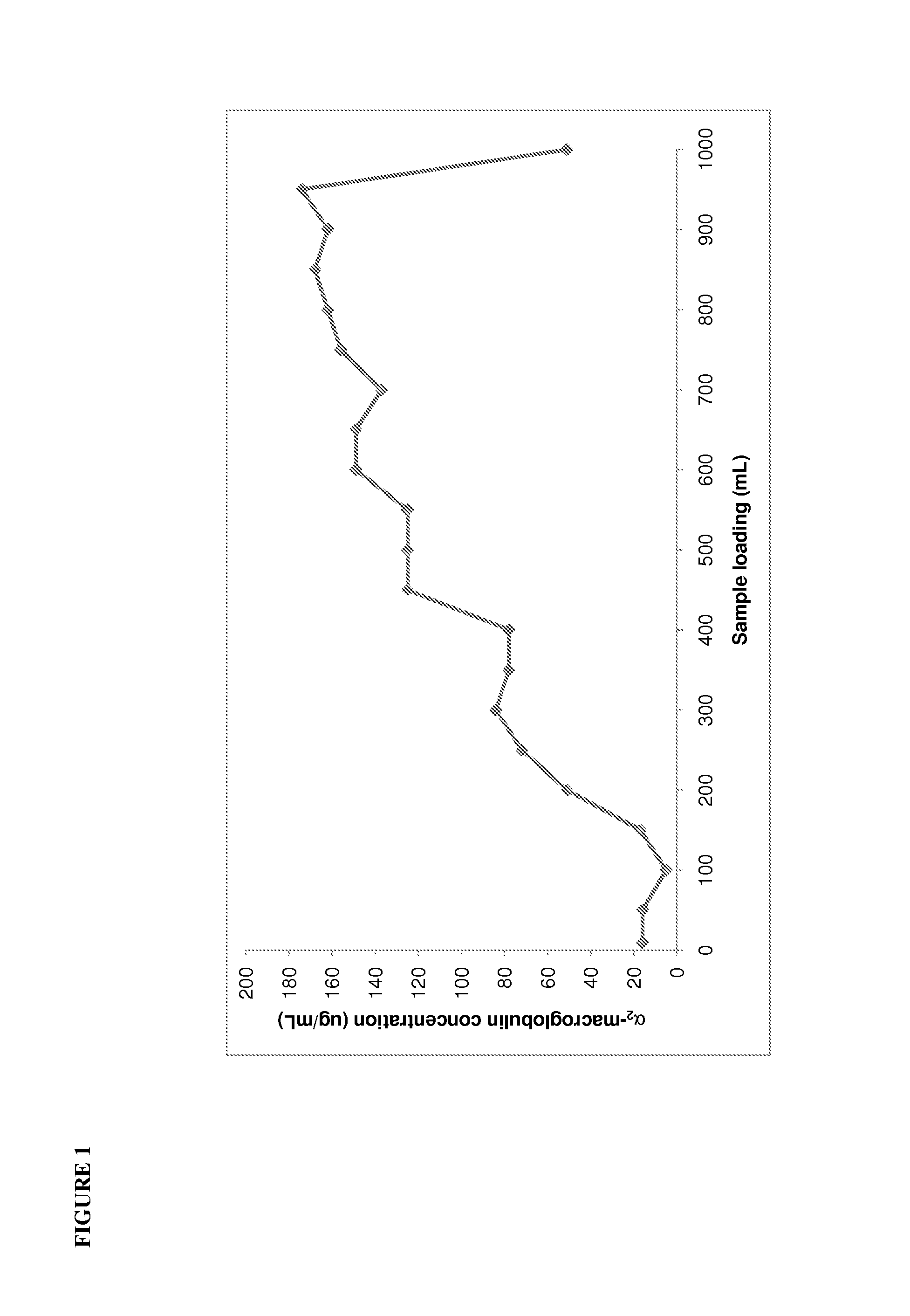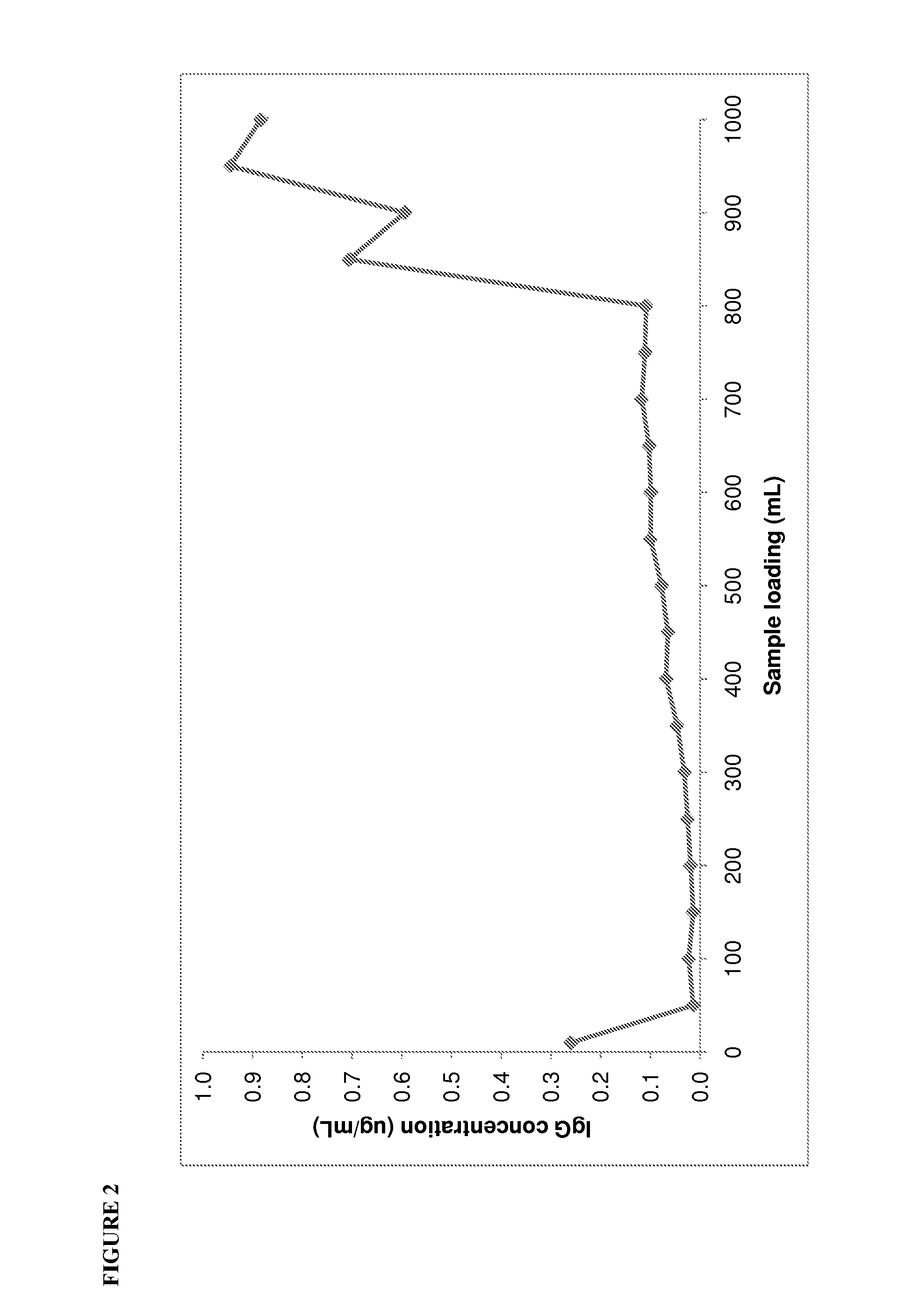Method for polishing albumin
a technology of albumin and chromatography, which is applied in the field of purifying albumin from solution, can solve the problems of limited industrial application and wide adoption of chromatographic processes for fractionation of human albumin
- Summary
- Abstract
- Description
- Claims
- Application Information
AI Technical Summary
Benefits of technology
Problems solved by technology
Method used
Image
Examples
example 1
Characterisation of Sephacryl S200HR Process
[0115]Before commencing development studies for the MEP Hypercel, the current Sephacryl S200HR polishing step was fully characterised to identify the major contaminant proteins present in the albumin intermediate and understand the effectiveness of the Sephacryl S200HR at removing these contaminants. The albumin intermediates before and after Sephacryl S200HR chromatography were characterised using nephelometry (IMMAGE Immunochemistry system, Beckman-Coulter Inc., Fullerton, Calif., USA) to determine the levels of albumin, IgG, IgA and IgM, and immunoelectrophoresis to determine the levels of transferrin, α2-macroglobulin, α1-glycoprotein, α1-antitrypsin, inter α trypsin inhibitor, haptoglobin, apolipoprotein A1, apolipoprotein B and ceruloplasmin.
[0116]The concentrated ion exchange albumin intermediate which is loaded on to the Sephacryl S200HR contained 1.42% impurity proteins, of which α2-macroglobulin, IgG and IgA were the predominant ...
example 2
Impact of Heating on Turbidity of Albumin Solutions
[0117]The safety record of commercial albumin solutions is attributed largely to the pasteurisation step (60° C. for 10 hours) [More & Harvey, 1991]. The albumin solution is stabilised by addition of sodium caprylate, however the presence of contaminant proteins which are not protected by the caprylate are susceptible to heat induced denaturation during pasteurisation. A control sample of albumin intermediate eluated from CM Sepharose-FF chromatography and intermediate samples of purified albumin derived from Sephacryl S200HR chromatography were concentrated to 15-20% w / v protein by ultrafiltration (10 kDa OMEGA membrane; Pall Life Sciences, USA) and formulated with 32 mM sodium caprylate. These samples were not subjected to the low pH caprylate incubation step. The samples were then pasteurised by heating at 60° C. for 10 hours. At the completion of pasteurisation, the turbidity of the samples was assessed using a Hach 2100AN Turbi...
example 3
Determination of MEP Hypercel Operating Conditions
[0119]The operating parameters for MEP Hypercel chromatography were explored using purified samples of albumin and IgG. The binding and elution of albumin and IgG was determined separately using a range of equilibration conditions including; 50 mM sodium phosphate (pH 7.0); 50 mM sodium acetate (pH 5.5); 50 mM sodium acetate (pH 5.5)+150 mM NaCl; 50 mM sodium acetate (pH 5.5)+300 mM NaCl; 50 mM sodium acetate (pH 7.0); and 110 mM sodium acetate (pH 7.0). The purified IgG and purified albumin samples were prepared in the appropriate equilibration buffer at a concentration of approximately 5-10 mg / mL and filtered through a 0.22 μm membrane (Durapore®, Millipore Corporation, Bedford, Mass., USA) prior to chromatography. The samples were loaded on to an equilibrated MEP Hypercel column (17.5 cm×1.6 cm ID; GE Healthcare BioSciences AB, Uppsala, Sweden) at 20 g per litre of resin. The unbound protein was recovered during the sample loading...
PUM
| Property | Measurement | Unit |
|---|---|---|
| Fraction | aaaaa | aaaaa |
| Molar density | aaaaa | aaaaa |
| Density | aaaaa | aaaaa |
Abstract
Description
Claims
Application Information
 Login to View More
Login to View More - R&D
- Intellectual Property
- Life Sciences
- Materials
- Tech Scout
- Unparalleled Data Quality
- Higher Quality Content
- 60% Fewer Hallucinations
Browse by: Latest US Patents, China's latest patents, Technical Efficacy Thesaurus, Application Domain, Technology Topic, Popular Technical Reports.
© 2025 PatSnap. All rights reserved.Legal|Privacy policy|Modern Slavery Act Transparency Statement|Sitemap|About US| Contact US: help@patsnap.com



